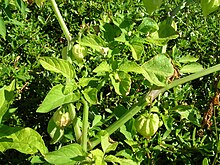Physalis angulata is an erect herbaceous annual plant belonging to the nightshade family Solanaceae. Its leaves are dark green and roughly oval, often with tooth shapes around the edge. The flowers are five-sided and pale yellow; the yellow-orange fruits are borne inside a balloon-like calyx. The exact native range is uncertain.[2][3][4] The species may be naturally endemic to Australia[5] or the Americas[6] or the native range may encompass both the Americas and Australia.[7][5] It is now widely distributed and naturalized in tropical and subtropical regions worldwide.
| Physalis angulata | |
|---|---|
 | |
| Cutleaf groundcherry | |
| Scientific classification | |
| Kingdom: | Plantae |
| Clade: | Tracheophytes |
| Clade: | Angiosperms |
| Clade: | Eudicots |
| Clade: | Asterids |
| Order: | Solanales |
| Family: | Solanaceae |
| Genus: | Physalis |
| Species: | P. angulata |
| Binomial name | |
| Physalis angulata | |
| Synonyms[1] | |
|
List
| |
The plant produces edible fruit that can be eaten raw, cooked, jammed, etc. However, all other parts of the plant are poisonous.[8] Members of the Toba-Pilagá ethnic group of Gran Chaco traditionally eat the ripe fruits raw.[9] Unripe raw fruits, flowers, leaves, and stems of the plant contain solanine and solanidine alkaloids that may cause poisoning if ingested by humans, cattle or horses.[10][11]
Vernacular names
- English common names include: angular winter cherry,[12] balloon cherry,[12] cutleaf groundcherry,[12][13] gooseberry,[12] hogweed,[12] wild tomato, camapu, and occasionally other common names for the genus Physalis.
- In Spanish it is known as bolsa mullaca[14]
- In Malayalam it is known as njottanjodiyan and mottaampuli.
- In Indonesian it is known as ceplukan or ciplukan.
- In Sundanese, it is known as cecendet
- In Suriname it is known as batoto wiwiri.
- In Meru it is known as Nkabakabu.
- In Egyptian Arabic it is known as Hrankash.
- In Yoruba it is known as Koropo
- In Guarani it is known as Kamambu
References
External links
Wikiwand in your browser!
Seamless Wikipedia browsing. On steroids.
Every time you click a link to Wikipedia, Wiktionary or Wikiquote in your browser's search results, it will show the modern Wikiwand interface.
Wikiwand extension is a five stars, simple, with minimum permission required to keep your browsing private, safe and transparent.